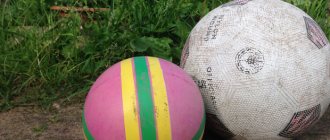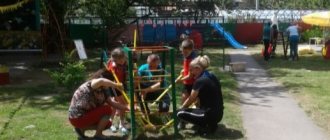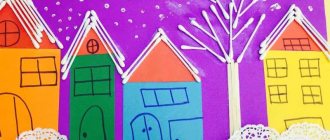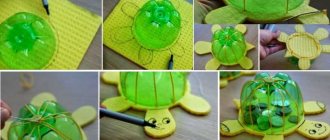Construction in kindergarten for children of senior preschool age
The article presents game tasks with a construction set developed by O.A. Skotnikov, Educator of Russia-2013.
The formation of constructive activity is an important stage in the mental development of a child. The level of development of constructive activity determines the level of development of visual-effective and visual-figurative thinking in a child. As is known, theoretical mental analysis and synthesis are preceded by practical analysis and synthesis of things in action, that is, first formed in practice, analysis and synthesis then become operations of the theoretical thought process. This is why design in kindergarten is so important.
The ability to analyze graphic images - to isolate their constituent elements, relate them to each other, synthesize a graphic image - the famous domestic psychologist A.R. Luria called visual analysis and experimentally proved the importance and necessity of developing this mental quality for a successful start to school.
Violation of the development of optical-spatial gnosis, a delay in the formation of spatial representations, unformed visual perception, underdevelopment of fine motor skills, and insufficient development of mental activity are considered characteristic of children with speech pathology. Therefore, construction in kindergarten can be considered a correctional activity for children with general speech underdevelopment, capable of solving many problems, namely: development
- hand-eye coordination,
- oculomotor functions,
- fixation of gaze,
- verbal orientation,
- fine motor skills of the fingers,
- the ability to divide a complex shape into its component parts,
- relate the sizes of objects,
- determine their location and mentally change their relative position.
I bring to your attention practical game tasks for children 5-6 years old.
All tasks are arranged in order of increasing difficulty level and are aimed at gradually developing the skills to independently perform design activities.
I start construction in kindergarten with older children with practical tasks with sticks. The entire set consists of 20 sticks, with the help of which the child lays out various silhouette figures .
This activity allows you to teach the child to recreate the whole of an object from segments and translate practical, external actions into an internal plan.
After the task is completed, it is necessary to determine together with the child whether the result corresponds to the given standard, whether the methods suggested by adults were used, and to give an overall assessment of the work.
Further work is carried out with a flat triangular constructor, which we called “Fairy Triangles”. The entire set of the designer consists of 16 isosceles right triangles of different sizes, obtained by cutting three squares with a side of 10 cm, as shown in the figure:
All work with this constructor is divided into 6 stages:
At the first stage, the child must learn to conduct a visual analysis of the position of one triangle, focusing on its three sides, one of which is long, and the other two are short and equal in length. Therefore, to begin with, let the child try to place his triangle on the table, in accordance with the sample. Such a triangle can have up to 8 different positions.
At the second stage, the child receives another triangle and tries to make new geometric shapes from them, such as a square, a triangle and a quadrilateral. Moreover, children should always be asked how they got this or that figure? Which sides do you need to connect the triangles to make a square, triangle or quadrilateral? That is, verbalization of practical actions is necessary.
At the third stage, the child receives two more triangles. In this case, the teacher can give hints, for example: “Build a rectangle from four triangles. But don’t forget that any rectangle can be folded from two squares, and you already know how to make squares from triangles” or “You know that a square can be folded from two triangles, and by building two large triangles from small ones, you can fold them into square".
The same hints can be given by children themselves who have completed the task on their own; in extreme cases, the result can always be shown on a magnetic board using four large triangles.
In the fourth stage, 2 large triangles and 4 medium ones are used.
From this set of triangles, children make different geometric shapes using patterns. The children came up with some of the methods themselves.
At the fifth stage you will need 8 small triangles.
The tasks are made more difficult by the fact that the samples gradually become semi-dismembered.
At the sixth stage you will need 2 large triangles, 4 medium ones, 8 small ones (the whole set).
At this stage I tried to make some kind of synthesis of construction and fairy tales. Children, listening to a fairy tale, make up a plot picture based on the model, using the entire set of construction sets.
Fairy tale "Zayushkina's hut."
Once upon a time there lived a fox and a hare. The fox had an ice hut, and the hare had a bast hut. Spring has come - the fox’s hut has melted, but the hare’s hut remains as before.
The fox asked the bunny to warm up and kicked him out of the hut. A bunny walks and cries, and a dog meets him. -What are you crying about, bunny? - How can I not cry? I had a bast hut, and the fox had an ice hut. Spring came, her hut melted - she asked me to warm up and kicked me out. “Don’t cry, bunny,” says the dog, “I’ll kick him out.”
They approached the hut. - Av-av-av! Get out, fox! And the fox told them from the stove: “As soon as I jump out, as soon as I jump out, the pieces will go down the back streets!” The dog got scared and ran away.
The bunny sat under a bush and cried. A bear is walking by. -What are you crying about, bunny? - How can I not cry? I had a bast hut, and the fox had an ice hut. Spring came, her hut melted - she asked me to warm up and kicked me out. “Don’t cry, bunny,” says the bear, “I’ll kick her out.” - No, bear, you won’t kick me out. The dog chased him, but he didn’t kick him out, and you won’t kick him out. - No, I’ll kick you out!
Let's go to the hut. The bear roars: - Get out, fox! And she said to him from the stove: “As soon as I jump out, as soon as I jump out, pieces will fly through the back streets!” The bear got scared and left.
A bunny sits under a bush and cries. A cockerel walks past, wearing a golden comb, and carrying a scythe on his shoulder. He saw a bunny and asked - Why are you crying, bunny? The bunny told him about his misfortune. “Come on, I’ll kick her out,” says the cockerel. - No, you won’t kick me out. The dog chased but didn’t drive him out, the bear chased him but didn’t drive him out. - I’ll kick you out, let’s go!
We approached the hut. The rooster crowed: - Ku-ka-re-ku! I carry the scythe on my shoulders, I want to whip the fox. Get out, fox! And the fox got scared and said: - I’m getting dressed... - Ku-ka-re-ku! I carry the scythe on my shoulders, I want to whip the fox. Get out, fox! And she says: - I’m putting on a fur coat... The rooster crows for the third time: - Ku-ka-re-ku! I carry the scythe on my shoulders, I want to whip the fox. Get out, fox! She jumped out of the hut and ran into the forest. And they began to live, to live in a bast hut.
Based on the fairy tale "Geese and Swans".
Once upon a time there lived a man and a woman. They had a daughter and a little son. “Daughter,” the mother said, “we’ll go to work, and you take care of your brother.” Don't leave the yard anywhere.
The father and mother left, and the daughter forgot that she was being punished: she sat her brother down on the grass under the window, ran outside and started playing. Geese-swans swooped in, picked up the boy and carried him away on their wings. The girl returned, and lo and behold, her brother was gone! She ran out into an open field and only saw how the geese-swans carried away their brother beyond the dark forests.
The girl rushed to catch up with them. She ran and ran and saw that the stove was standing. - Stove, stove, tell me, where did the geese-swans fly? The stove answered her: “Fix my pipe,” I’ll tell you. Shall we help the girl fix the pipe?
The stove showed where the swans had flown. The girl ran further. He sees an apple tree standing. The apples on the apple tree are ripe. It’s hard for an apple tree to hold so many apples - the branches are about to break. - Apple tree, apple tree, tell me, where did the geese-swans fly? “Take the apples off me,” I’ll say. The girls picked all the apples from the apple tree. There is an apple tree without a single apple - he can’t get enough of it. Can you pick an apple tree without apples?
The apple tree showed where the geese and swans had flown. The girl ran further. On the girl’s way there is a deep river with steep banks. - River, river, where did the swan geese fly? “I would tell you,” says the river, but what’s the point. The bridge over me has broken. Now, if you could fix it... Shall we help the girl fix the bridge?
The girl crossed the river across the bridge and ran on. She ran for a long time through the fields and forests. The day is approaching evening, there is nothing to do - we need to go home. Suddenly he sees a hut standing on chicken legs.
The girl walked around the hut and saw her brother sitting on the porch, playing with silver apples. The girl took her brother and ran. Geese-swans - in pursuit. On the way home, the river hid them under the bridge, the apple tree covered them with branches, and the stove behind the door. The geese-swans flew and flew, screamed and shouted, and flew back empty-handed. And the girl and her brother ran home, and then the father and mother came.
After training with a triangular construction set, the children are ready to master other flat construction sets that consist not only of triangles, such as Pythagoras and Tangram.
I want to introduce another flat geometric constructor, which can be called “Pythagoras-2”.
A square measuring 10x10 cm is cut as shown in the figure, resulting in 9 geometric shapes: 4 large triangles, 2 small ones, one medium one, a square and a rectangle.
Before working with samples, the guys complete several tasks with certain figures.
Task 1. Take 2 large triangles and a square. Make: a rectangle, a triangle and 2 different quadrangles, one of which is a trapezoid.
Task 2. Take 2 small triangles and a medium one. Make: a square, a triangle, a rectangle and 2 different quadrangles, one of which is a trapezoid.
Task 3. Take 2 small triangles, a medium and a large triangle. Make: a square, a triangle, a rectangle and 2 different quadrangles, one of which is a trapezoid.
Next, children build different images, gradually moving to undifferentiated samples.
The next construction set is also made by the author and, by analogy with the “Tangram”, I called it “Tregram” , since it was obtained by cutting an equilateral triangle. Game tasks with such a constructor can be carried out on filling and composing planar images from sets of geometric shapes. An equilateral triangle made of cardboard (side length 20 cm, each of which is divided into 5 equal parts of 4 cm) is cut into 10 shapes, as shown in the figure.
The result is 4 small triangles, 2 rhombuses, a trapezoid, a parallelogram, a large triangle and a hexagon.
All work is also being built in stages.
At the first stage, children become familiar with all the parts of the construction set, making them up from triangles and other small shapes:
1. By connecting two triangles to each other, children get a rhombus. 2. By attaching another triangle to the rhombus, children get a trapezoid, which can also be made using three triangles. 3. By attaching another triangle to the trapezoid, children get a parallelogram. The same figure can be made from other small figures. 4. Next, by superimposing small figures on large ones, children themselves draw conclusions from which figures they can be combined.
At the second stage, children fill out the internal space of the silhouette figures on the sheets, using all parts of the construction set.
At the third stage, children make planar images using dissected samples with a gradual transition to partially dissected ones.
At the fourth stage, children model images according to their own ideas.
I made another flat construction set . This set consists of 15 squares 5x5 cm:
- 8 squares are filled half diagonally;
- 3 squares are completely painted;
- 4 squares are pure white.
At the first stage of game tasks, we use only 4 squares, half-shaded, and according to the sample, we make up all the images only from them.
In the second stage, children make images of 9 squares using the entire set.





